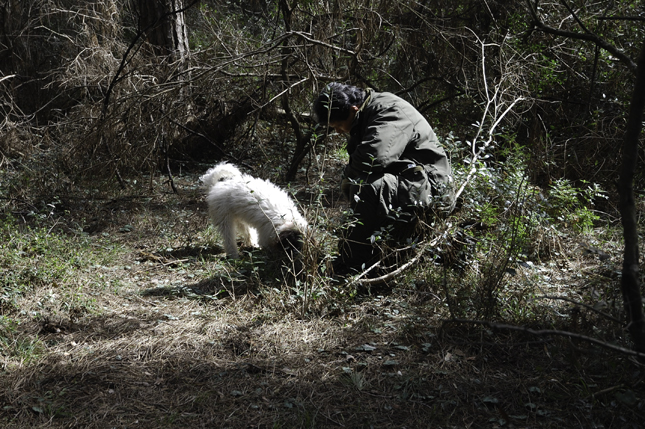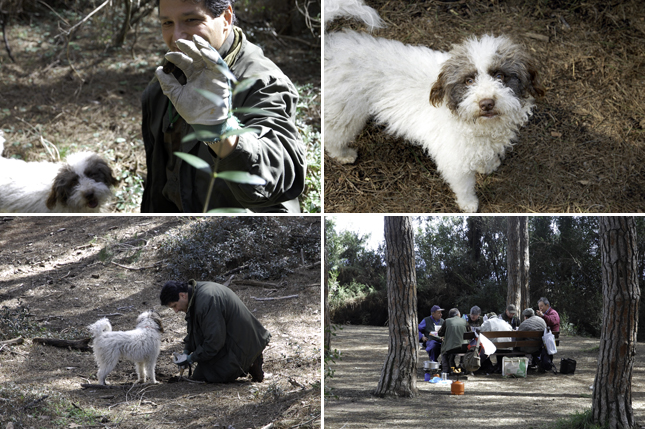Truffle Hunting in Tuscany's Maremma

Truffles possess one of nature’s unique aromas; a scent that, as Goethe said of Venice, “...can only be compared to itself.” With their pungent earthiness, their muskiness and the very oddness of their shapes, truffles have driven people to distraction for 3,600 years, with a bit of a respite in the Middle Ages when they fell from vogue when it was believed that anything found under the soil had been put there by the devil. Truffles came back into style during the reign of Louis XIV. The king’s mistress, Francoise Athenais de Montespan had great influence over Louis for nearly a decade and coaxed the king into trying many things he would not otherwise have. To please his notoriously difficult to please mistress the king commanded his chefs to integrate truffles into his favorite dishes, initiating another of his many royal fads.
The average truffle weighs in at 1 to 3 ounces (28 to 85g) and, depending on the type and quality net anywhere from US$65/€50 to US$132/€100 per kilo for restaurant grade, to US$265/€200 to US$395/€300 for premium grade and about U$5,400/€4,000 per kilo for the favored white truffles. People pay big bucks for truffles mainly because of their scarcity and the skill it takes to find them but beyond the arduousness of truffle gathering there is an intrinsic sensuality, even something transcendental about the aroma of this blob-shaped fungi that drives some to empty their wallets. In 2007 a white truffle weighing 3.3 lbs. (1.49 kg) was found by Cristiano Savini’s dog, Rocco near Pisa and was auctioned off to a casino owner from Macau for US$330,000.¹

Truffle secrete a component called androstenol, the same hormone produced by boars during mating times. The smell is so powerful that when female sows are let loose in the woods they fly into a frenzy and rummage with abandon for all the truffles they can find — thus the birth of the pig as truffle hunter. The major drawback of the sow is that she often refuses to share her finds and many of her handlers have lost fingers in their attempts to wrest a truffle from a her jaws. The use of sows is becoming less common though there are still a handful of trainers in France who specialize in taming them.
The use of dogs can be traced back to the 16th century, specifically to a dukedom in the Val d‘Comacchio, near Ravenna. This area was a duck hunters paradise and was where the truffle hunting breed of today, the Lagotto Romagnolo, originated. In the 18th century the marshes that were once the hunting grounds of the dogs and their dukes were drained to create arable farmland— thus the birth of the Lagotto Romagnolo as truffle hunter. According Stefano Braccini, founder of Tartufie e Cani in Tuscany, the Lagotto Romagnolo, “...took over 20 years of breeding to get to the perfect dog. All the difficult characteristics are now lost. Today it is the perfect breed.” The Italian truffle dogs have had their hunting instinct breed out of them so when out in the woods they are never distracted by birds or other game.
 Stefano and Rocky hunting truffles and a group of hunters dining in the forest
Stefano and Rocky hunting truffles and a group of hunters dining in the forest
In appearance the dogs look half Portuguese Water Dog and half poodle with eerily human eyes. They are wonderfully affectionate, are very attached to their masters and have one of the keenest noses in all of dogdom. Another great trait is stamina. “Most truffle hunting dogs,” explains Stefano, “usually tire out after two hours of hunting. Their sense of smell fatigues. The Lagotto can go all day.”
Out hunting for the marzuolo truffle with Stefano and his dog Rocky, as in Balboa, as in the Italian Stallion, is an amazing event to observe. One in which human and dog interact in perfect unison. Moving through the beachside forests of Grosetto Province, near the resort town of Cecina, Stefano repeats, “Dove? Dove?” (Where? Where?) in a calm voice as the dog trots from scent to scent. “Rocky can find truffles the size of a peanut buried as far down as 50 centimeters,” says Stefano. That’s over one foot underground. Within moments the dog has found one, then another, then three in one place. With each find Stefano rewards the dog with a treat and praise. Both are clearly happy.
Stefano Braccini, a truffle hunter and dog trainer in the town of Cellai, in the commune of Rignano sull’Arno, is one of approximately 200 registered professional foragers. In all of Italy there are approximately 4,000 truffle hunters but Stefano is different— he is possibly the only trainer in the country that practices the Metodo Gentile or Kind Technique.
To learn more about Stefano Braccini and his dogs visit:
www.tartufiecani.info
E-mail: tartufiecani@live.it
Special thanks to translator Marya Dumont
Marya studied French literature and Occitan sociolinguistics, then sampled the yuppie lifestyle at Microsoft before becoming a travel-hungry expat, tour planner and guide with Butterfield & Robinson. Her favorite place on the planet is Piemonte: home of Slow Food, savory autochthonous grape varietals, and a large per capita population of trifulaos.
1 Portions of the truffle auction proceeds were donated to an Italian group that assists people with genetic disorders, a London organization that helps homeless children and a Catholic charities group in Macau
2 Research netted only one significant mention of the truffle written in 1481 by Bartolomeo Platina, a papal historian in Avignon who commented that the sows of Notza in upper Provence, “...were without equal in hunting truffles however they should be muzzled to prevent them from eating the prize.”






 Share Article
Share Article
Reader Comments (4)
Thank you for this wonderful post! (It was a particular treat to listen to that forest full of birdsong in the video.)
Stefano and Rocky rock! (And so does your blog.)